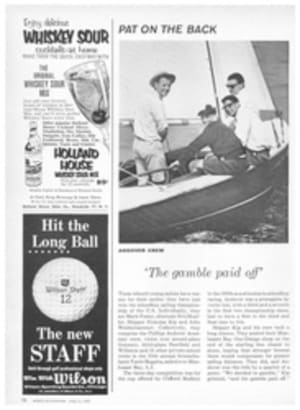
BEAUTY ON THE BARS
The Greeks, who had the right word for everything, had no trouble at all in finding a name for those places where competitors in public games were trained. Since all athletes practiced and competed entirely unclothed in those heroic days, the Greeks called their training quarters gymnasiums, taken from a word which meant, simply, naked. Perhaps this is one reason why over the centuries gymnastics has been a sport in which the human body is just as much admired for the way it looks as for the way it performs. It also explains why the pert and pocket-sized Aphrodite on the opposite page is considered in gymnastic circles to be one of the finest women athletes in the world.
Her name is Ernestine Jean Russell; she is 22 years old, exactly five feet tall, and her 110 pounds are becomingly distributed over a marvelously supple body—dimensions 35-24-34. The record proves that she is the best woman gymnast in North America, and it may well be that she is the prettiest woman athlete in competition anywhere.
A Canadian by birth but an American bride for the last seven months, Ernie Russell is a senior in physical education at Michigan State University. Last week between summer classes she was spending five to six hours a day in MSU's cavernous and deserted field house gym, perfecting her routines for the Canadian Olympic tryouts, which take place soon. Actually, Ernie's ticket to Rome was as good as bought. There are few gymnastics prizes she has missed once she set out after them. In the nine years since she entered competition as an 85-pound high school freshman, she has nipped, balanced and tumbled her way to 106 regional, state and national championships. She has won the Canadian women's championship six times in a row. She won the U.S. title three times and was an odds-on favorite to win it again this year before she stepped out of the competition because it was also a try-out for the Olympics.
A three-year record
Canada—at least, all of Canada that reads the newspapers—and Ernie have had a love affair for years now. She was chosen Canadian amateur woman athlete of the year three years in a row, a record equaled only by Figure Skater Barbara Ann Scott. Ernie's picture appears in Canadian newspapers as regularly as a movie starlet's.
It was largely because of Ernie's spectacular routines that Canada decided to send a gymnastics team to Melbourne at all. It had not taken part in Olympic gymnastics since 1912. In fact, Ernie has sparked a revived interest in gymnastics all over the country. Some people contend that it was because of the publicity he got while directing her career that Ernie's old coach, Bernard Newman, a high school teacher, was elected to the Windsor council and, eventually, to the legislature.
In 1958, when Ernie was the only woman among 88 gymnasts invited to Moscow to participate in Russia's World Gymnastics Championships, there was an angry spate of headlines in Canadian newspapers over reports that she had been bundled out of Moscow as soon as the contest was over, without even being given a tourist's privilege of looking around. The headlines grew blacker daily, and there was even talk of an official protest being lodged, when Ernie arrived home, exhausted and somewhat underweight, and put the story straight. She had not been booted out of Moscow; in fact, she had been treated warmly and hospitably by both her Russian competitors and Russian audiences. The mix-up apparently occurred because her coach, Bernie Newman, had complained about Russian food and about the fact that Russian officials would not let him stop off in the Ukraine on his way out of the country.
Ernie likes the Russians as competitors, but more than anything else she is grateful to them for showing her a gymnastics style she never knew existed until she saw them make a sweep at Melbourne. "They are far superior to any gymnasts in the Western countries," she says. "Our big trouble is that our gymnastics routines have always been based on men's routines. The Russians have an entirely new technique, and it's breathtaking and beautiful. Instead of taking a position and holding it, they are in constant motion all the time. They take one position and slide into another and another. It's closer to ballet than anything I can think of. Their extensions—the movements of arms and legs—are straight out of ballet. Where girls in the West raise their legs only up to here...they go way up to there. Until we reached Melbourne we weren't even aware that they did their routines to music. It makes all the difference in the world. The Russians try for grace, not just acrobatics. And don't let anyone tell you Russian women are chunky and muscular. Why, most of their gymnasts look like ballerinas, tall and slim and graceful."
Since Melbourne and again since Moscow, Ernie has altered her style and routines, but she does not think she will ever catch up to the Russians. After she graduates from MSU this year, however, she plans to teach physical education at Everett High School in Lansing, and she is grimly determined to have the best girls' gymnastics team in the U.S. "Boy oh boy! The things I've got to teach," she says. "I may not ever be able to catch up, but at least I have something to pass on. Why, nearly everywhere you look gymnastics is being taught incorrectly. I'm always seeing little girls with more nerve than a sore tooth doing something like, say, a back flip with a full twist. They think because it's difficult they'll impress judges. That's because they haven't seen the Russians and don't know any better."
Russian routines are better
Although he groused publicly at Melbourne when he first saw the Russian girls in action ("All you need is a few little ballet steps and you get high points"), Coach Newman now agrees with Ernie that the Russian system is better. He has changed his style of teaching, and since he and Ernie probably have more effect on gymnastics than any other two people in North America, most U.S. and Canadian coaches will fall in line. Newman also admits that he and Ernie together probably fixed the present U.S. style. "When I started coaching I knew nothing about women's gymnastics," he says, "so I just taught them the same as men. In the men's routines you use a lot of muscle. There are spots where they hold a position for one or two seconds. I taught the girls to do this. Then in May 1955 Ernestine won the U.S. national championships at Rochester, the first time any competitor ever won 10 firsts in the 10 events. This sweep caused the best American coaches to follow her style. After all, if a girl from a backwoods country like Canada can come down and win every event, she must be doing it the right way. Now, a lot of American girls who copied her style after that meet are changing to Ernie's new style. Sure, we changed a lot of things after we found out for the first time how they do it in Europe."
Although Newman no longer coaches Ernie full time and they frequently dispute each other in print, they are still close and affectionate friends. It would be difficult to say whose gymnastics career has benefited more from their long association. It began back in 1952 when Ernie began tagging along with neighborhood kids down to a vacant lot near her home in Windsor where Newman had set up some bars and a trampoline for the Windsor Gymnastics Club, which he coached in his spare time. "I watched for a few afternoons," Ernie recalls, "and then I asked Bernie if I could jump on the trampoline. He said I could, so I took off my shoes and got on it. They darn near couldn't get me off after that."
Actually, Ernie already had more than enthusiasm. Her mother, Rene, who had a brief career as a professional dancer, runs a dancing school in downtown Windsor, and Ernie had been taking ballet and acrobatic dancing since she was 4. Her father, Donald, a foreman at the local Ford plant, had been something of an athlete when he was a youth in Edinburgh, Scotland, and he had taught Ernie a few acrobatic tricks, such as cartwheels and handstands. In no time at all, Newman recognized her natural aptitude for gymnastics and took her in hand.
Unlike some youngsters, Ernie didn't mind practicing, and to this day she finds gymnastics sheer fun. "It's all I ever wanted to do," she says. "I've really had a ball."
It was in June 1952 that Ernie first stepped on a trampoline. In just over two years she was Canadian champion, had won more than 50 firsts in gymnastics contests from Chicago to New York and had been twice named Canada's outstanding woman athlete of the year.
An offer from Michigan
When she graduated from Windsor's Kennedy Collegiate high school in 1954 with a B average, Ernie was inundated with scholarship offers. One of these, for tuition only and subject to her passing a proficiency test, was from Michigan State. Ernie took it because she knew that MSU's gymnastics coach, George Szypula, was one of the finest. She also was aware that the school had one of the most elaborate athletic plants in the nation. Unfortunately, things never quite worked out as she had planned. For one thing, working with Szypula full time also meant working at men's gymnastics with the men's team. But Ernie has received some special coaching from Szypula, she has full use of half a dozen splendidly equipped gyms and her gymnastics exhibitions have made her a campus queen.
She also met her husband, John Carter, at MSU, where he was a star baseball player. They were married last December, after his graduation, and he is now an assistant ticket manager in State's athletic department. They live in a small efficiency apartment in faculty quarters on the East Lansing campus.
Twice within the last three years Ernie has had overtures from movie scouts, but so far nothing has come of them. She has no particular objection to turning professional when she graduates and takes up teaching but, as she points out, there is really not much scope for a gymnast in show business. "When people think of gymnasts," she says, "they think of those muscled ladies in the circus. There's always acrobatic dancing, of course, but I don't think I would be interested in that."
Bernie Newman has no doubts at all about Ernie's future. "Gymnasts are a hardy breed," he says. "They go on until they are past 40. She could have a family and, if she keeps her figure, come back to the sport in later years. One woman in the last Olympics was over 40 and she won points. Like show business, this gets in your blood. You hate to give up the roar of the crowd and the feeling of being the center of attraction."
PHOTO
ART SHAY
PRACTICING ROUTINES in Michigan State gym, Ernie shows near-perfect form.
PHOTO
ART SHAY
ERNIE MAINTAINS A DIFFICULT ONE-ARM BALANCE WITHOUT REVEALING STRAIN
PHOTO
ART SHAY
IN CAMPUS HONEYMOON FLAT, ERNIE AND HER HUSBAND JOHN CHECK UNIFORMS

